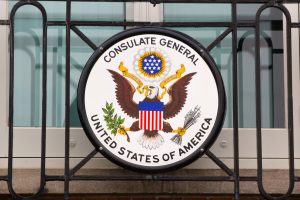What is H1-B Consular Processing?
H1B consular processing means getting an H1-B visa stamp at a US embassy outside of the US.
Who is Eligible For Consular Processing?
If you are currently in the USA on a visa like F1 or H4, and you also wish to apply for H1B lottery you can either apply for a change of status or opt for consular processing.
Is Consular Processing Mandatory for Adjustment of Status?
- Consular processing is not mandatory for Adjustment of Status
- It is not necessary to go to your home country, in most cases
- If you are in the USA and want to change your status, you don’t need to go out of the USA to activate your H1-B
- However, in certain situations it’s preferable to file for consular processing
Under What Circumstances Should I Opt for Consular Processing?
You May Need to File for Consular Processing Under The Following Circumstances:
- You have filed your H1-B lottery application as ‘Consular Processing’ application
- You joined a new H1-B employer B on receipt and your pending H1B extension from employer A receives RFE after I-94 expiry
- Your H1-B transfer may receive an RFE to wait for employer A’s bridge extension decision before your H1-B transfer can be approved with a new I94
- Many employers in this situation decide to opt for H1-B consular processing rather than waiting for the pending employer A’s extension
- If you travel outside the US while H1-B Change/Extension of Status is pending
- USCIS will automatically abandon your pending H1B change or extension of status application if you travel while your application is pending
- USCIS will approve your H1-B, but with consular processing
- Hence, you have to H1-B stamp and then enter the US in this case
What are the Advantages of Consular Processing?
- You can somewhat determine the date of your H1-B activation
- In the case of first-time lottery H1-B change of status from F1 (OPT/CPT) to H1B or H4 to H1B, it is better to file for a consular processing
- USCIS approval without consular processing will immediately change your status. They will issue a new i94 immediately
- If you plan to keep working with OPT, CPT, H4 EAD, L2 EAD till the day you want, opt for “Consular Processing” while filing your H1B application
- By Choosing “Consular Processing”, you can choose to go out of the US and then enter using an H1-B visa at a date that you want to start working for the new employer
Can I Pursue Both “Adjustment of Status” and “Consular Processing” for the same I-140 Petition at the Same Time?
- You have to choose between Adjustment of Status and Consular Processing
- If you choose Adjustment Of Status on the Form I-40, and later choose to opt for Consular Processing, you have to file Form I-824 with the appropriate USCIS service center and wait until you receive the notice
- Many consulates may require approval of the Form I-824 (processing time vary, and may take over six months) before Consular Processing can begin
- However, if you choose Consular Processing and later decides on Adjustment of Status
- You can fill up the I-485 Adjustment of Status form, noting the change
- USCIS will send a letter acknowledging the change and requesting confirmation of the new choice of Adjustment of Status
- The previous choice (Consular Processing) will be canceled and the file transferred from the NVC to the Service Center adjudicating the application
- In either case, the change in selection will add several extra months to the usual processing times
Summary of Consular Processing Steps
Step 1: Form I-140, Immigrant Petition for Alien Worker, is filed with USCIS, requesting consular processing
Step 2: Upon approval of the I-140, USCIS sends notice of approval to the State Department’s National Visa Center (NVC).
Step 3: If a visa number is available for the applicant in the next year (varies by nationality and category of immigrant visa), NVC sends a fee bill for Immigrant Visa processing to the applicant/attorney of record
Step 4: Once payment is processed, NVC will forward an instruction packet (formerly called Packet 3) with forms and a list of supporting documents to be submitted by the applicant:
STEP 5
If you are applying for Consular processing, work with your lawyer, and gather appropriate documents before appearing for the in-person interview
- You must complete online form DS-160, Online Immigrant Visa Application.
- Upload your photo while completing the online Form DS-160
- Your photo must be in the format explained in the Photograph Requirements
STEP 6
- You must schedule an appointment for your visa interview, generally, at the U.S. Embassy or Consulate in the country where you live
- You may schedule your interview at any U.S. Embassy or Consulate, but be aware that it may be difficult to qualify for a visa outside of your place of permanent residence
- Wait times for interview appointments vary by location, season, and visa category, so you should apply for your visa early
- Check you wait time here
STEP 7
Prepare for your Interview
- Fees – Pay the non-refundable visa application fee, if you are required to pay it before your interview. When your visa is approved, you may also pay a visa issuance fee, if applicable to your nationality
- Fee information is provided here
- Review the instructions available on the website of the embassy or consulate where you will apply to learn more about fee payment
- L visa applicants included in an L blanket petition: You must also, pay the Fraud Prevention and Detection fee and may need to pay the Border Security Act fee
- Gather Required Legal Documents
- Please note additional documents may be required
STEP 8
Attend your Visa Interview
- During your visa interview, the consular officer will determine whether you are qualified to receive a visa, and if so, which visa category is appropriate based on your purpose of travel
- You will need to establish that you meet the requirements under U.S. law to receive the category of visa for which you are applying
- Ink-free, digital fingerprint scans will be taken as part of your application process
- They are usually taken during your interview, but this varies based on location
- You will also be informed by the consular officer if further processing is necessary for your application
What are the Disadvantages of Consular Processing?
- The biggest problem with H1-B consular processing is that you have to go through one more step of scrutiny with the visa officer
- It also raises issues of admissibility: if you have stayed beyond a period authorized by the Attorney General on Form I-94, you may be barred from entering the U.S. for up to 10 years
- Always results in in-person interview by the consular officer
- Some consulates may not give right to counsel at the interview
- There is no appeal or other administrative review available to challenge a negative decision by the consulate
- Processing times and success rates vary from country to country
- Availability of appointments depends on the individual consulate
- An inadequate interview may result in a request for additional evidence, and a subsequent interview, often two weeks or more after the first interview, at the consulate’s discretion
- Green card portability is not available.
- Concurrent filing with the I-140 Petition is not available
- The consular process is generally slower than Adjustment of Status
If you have any question or comments about consular processing of your overseas employee or have questions about the Green Card procedure in general, you can schedule a consultation with us:
Schedule a call at 469-994-9407 or contact us using the form.



